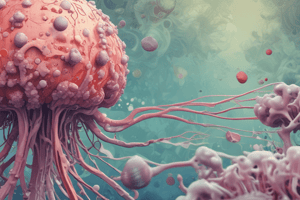Podcast
Questions and Answers
What are the goals of inflammation?
What are the goals of inflammation?
- To enhance the inflammatory reaction
- To cause tissue damage
- To contain and isolate injury, destroy microorganisms, and prepare the tissue for healing (correct)
- To promote infection
Which of the following is NOT one of the cardinal signs of inflammation?
Which of the following is NOT one of the cardinal signs of inflammation?
- Fatigue (correct)
- Swelling
- Heat
- Redness
What is the purpose of the 5Rs in the inflammatory reaction?
What is the purpose of the 5Rs in the inflammatory reaction?
- To cause chronic diseases
- To initiate autoimmune diseases
- To regulate the inflammatory response and promote healing (correct)
- To generate allergic reactions
Which condition may arise when the inflammatory reaction becomes excessive?
Which condition may arise when the inflammatory reaction becomes excessive?
What is the function of leukocytes in the inflammatory reaction?
What is the function of leukocytes in the inflammatory reaction?
What would happen if there was no inflammation in the body?
What would happen if there was no inflammation in the body?
What are the major components of acute inflammation?
What are the major components of acute inflammation?
What is responsible for the hotness and redness of the area during acute inflammation?
What is responsible for the hotness and redness of the area during acute inflammation?
What induces vasodilation of arterioles and capillaries during acute inflammation?
What induces vasodilation of arterioles and capillaries during acute inflammation?
What is the high protein concentration extravascular fluid containing cellular debris during an inflammatory reaction called?
What is the high protein concentration extravascular fluid containing cellular debris during an inflammatory reaction called?
What occurs as a result of the increased capillary permeability during acute inflammation?
What occurs as a result of the increased capillary permeability during acute inflammation?
What is the role of lymphatic vessels and lymph nodes in inflammation?
What is the role of lymphatic vessels and lymph nodes in inflammation?
What is the key function of leukocytes at sites of inflammation?
What is the key function of leukocytes at sites of inflammation?
What is the term for the process of leukocytes moving close to the vessel wall to detect and react to changes in the endothelium?
What is the term for the process of leukocytes moving close to the vessel wall to detect and react to changes in the endothelium?
What is the term for the extravascular fluid containing cellular debris during an inflammatory reaction?
What is the term for the extravascular fluid containing cellular debris during an inflammatory reaction?
What assists the phagocytes to undergo diapedesis or emigration through the endothelial junctions during inflammation?
What assists the phagocytes to undergo diapedesis or emigration through the endothelial junctions during inflammation?
Flashcards are hidden until you start studying
Study Notes
Goals of Inflammation
- Protect the body from injury or infection
- Restore tissue structure and function
Cardinal Signs of Inflammation
- Rubor (redness)
- Calor (heat)
- Tumor (swelling)
- Dolor (pain)
- NOT one of the cardinal signs: itchiness
The 5Rs of Inflammation
- Recognize the threat (pathogen or damage)
- React to the threat
- Remove the threat
- Restore the tissue
- Remember the threat (immunological memory)
Consequences of Excessive Inflammation
- Chronic inflammation, leading to conditions like arthritis, atherosclerosis, and cancer
Function of Leukocytes
- Defend the body against infection and disease
Importance of Inflammation
- Without inflammation, the body would be unable to defend itself against infection and disease
Components of Acute Inflammation
- Vasodilation
- Increased permeability
- Leukocyte extravasation
- Cytokine and chemokine production
Mechanisms of Acute Inflammation
- Histamine and prostaglandins responsible for vasodilation and increased permeability
- Bradykinin responsible for pain and increased permeability
Characteristics of Acute Inflammation
- Exudate: high protein concentration extravascular fluid containing cellular debris
- Edema: fluid accumulation due to increased permeability
Role of Lymphatic Vessels and Lymph Nodes
- Remove excess fluid and debris from the site of inflammation
- Activate immune response
Leukocyte Function
- Phagocytose foreign particles and debris
- Produce cytokines and chemokines to recruit more leukocytes
Leukocyte Migration
- Rolling: leukocytes move close to the vessel wall to detect and react to changes in the endothelium
- Adhesion: leukocytes bind to the endothelium
- Diapedesis: leukocytes migrate through the endothelial junctions
Terms Related to Inflammation
- Exudate: high protein concentration extravascular fluid containing cellular debris
- Diapedesis: leukocyte migration through the endothelial junctions
- PECAM-1 (CD31): assists phagocytes to undergo diapedesis
Studying That Suits You
Use AI to generate personalized quizzes and flashcards to suit your learning preferences.




